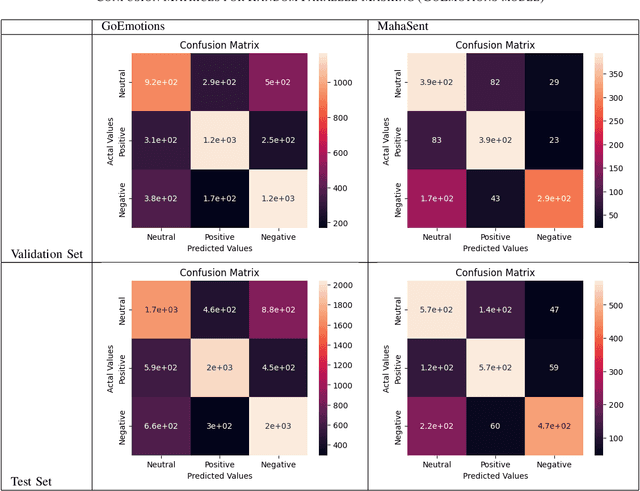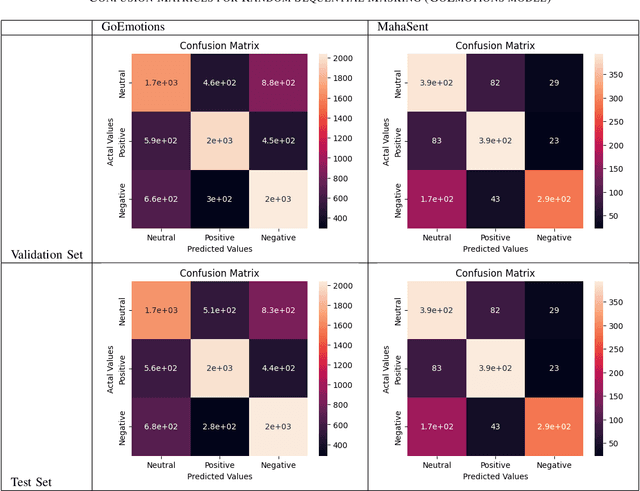Isha Joshi
Fluent but Unfeeling: The Emotional Blind Spots of Language Models
Sep 11, 2025Abstract:The versatility of Large Language Models (LLMs) in natural language understanding has made them increasingly popular in mental health research. While many studies explore LLMs' capabilities in emotion recognition, a critical gap remains in evaluating whether LLMs align with human emotions at a fine-grained level. Existing research typically focuses on classifying emotions into predefined, limited categories, overlooking more nuanced expressions. To address this gap, we introduce EXPRESS, a benchmark dataset curated from Reddit communities featuring 251 fine-grained, self-disclosed emotion labels. Our comprehensive evaluation framework examines predicted emotion terms and decomposes them into eight basic emotions using established emotion theories, enabling a fine-grained comparison. Systematic testing of prevalent LLMs under various prompt settings reveals that accurately predicting emotions that align with human self-disclosed emotions remains challenging. Qualitative analysis further shows that while certain LLMs generate emotion terms consistent with established emotion theories and definitions, they sometimes fail to capture contextual cues as effectively as human self-disclosures. These findings highlight the limitations of LLMs in fine-grained emotion alignment and offer insights for future research aimed at enhancing their contextual understanding.
Robust Sentiment Analysis for Low Resource languages Using Data Augmentation Approaches: A Case Study in Marathi
Oct 01, 2023



Abstract:Sentiment analysis plays a crucial role in understanding the sentiment expressed in text data. While sentiment analysis research has been extensively conducted in English and other Western languages, there exists a significant gap in research efforts for sentiment analysis in low-resource languages. Limited resources, including datasets and NLP research, hinder the progress in this area. In this work, we present an exhaustive study of data augmentation approaches for the low-resource Indic language Marathi. Although domain-specific datasets for sentiment analysis in Marathi exist, they often fall short when applied to generalized and variable-length inputs. To address this challenge, this research paper proposes four data augmentation techniques for sentiment analysis in Marathi. The paper focuses on augmenting existing datasets to compensate for the lack of sufficient resources. The primary objective is to enhance sentiment analysis model performance in both in-domain and cross-domain scenarios by leveraging data augmentation strategies. The data augmentation approaches proposed showed a significant performance improvement for cross-domain accuracies. The augmentation methods include paraphrasing, back-translation; BERT-based random token replacement, named entity replacement, and pseudo-label generation; GPT-based text and label generation. Furthermore, these techniques can be extended to other low-resource languages and for general text classification tasks.
L3Cube-MahaSent-MD: A Multi-domain Marathi Sentiment Analysis Dataset and Transformer Models
Jun 24, 2023



Abstract:The exploration of sentiment analysis in low-resource languages, such as Marathi, has been limited due to the availability of suitable datasets. In this work, we present L3Cube-MahaSent-MD, a multi-domain Marathi sentiment analysis dataset, with four different domains - movie reviews, general tweets, TV show subtitles, and political tweets. The dataset consists of around 60,000 manually tagged samples covering 3 distinct sentiments - positive, negative, and neutral. We create a sub-dataset for each domain comprising 15k samples. The MahaSent-MD is the first comprehensive multi-domain sentiment analysis dataset within the Indic sentiment landscape. We fine-tune different monolingual and multilingual BERT models on these datasets and report the best accuracy with the MahaBERT model. We also present an extensive in-domain and cross-domain analysis thus highlighting the need for low-resource multi-domain datasets. The data and models are available at https://github.com/l3cube-pune/MarathiNLP .
Implementing Deep Learning-Based Approaches for Article Summarization in Indian Languages
Dec 12, 2022

Abstract:The research on text summarization for low-resource Indian languages has been limited due to the availability of relevant datasets. This paper presents a summary of various deep-learning approaches used for the ILSUM 2022 Indic language summarization datasets. The ISUM 2022 dataset consists of news articles written in Indian English, Hindi, and Gujarati respectively, and their ground-truth summarizations. In our work, we explore different pre-trained seq2seq models and fine-tune those with the ILSUM 2022 datasets. In our case, the fine-tuned SoTA PEGASUS model worked the best for English, the fine-tuned IndicBART model with augmented data for Hindi, and again fine-tuned PEGASUS model along with a translation mapping-based approach for Gujarati. Our scores on the obtained inferences were evaluated using ROUGE-1, ROUGE-2, and ROUGE-4 as the evaluation metrics.
Hierarchical Neural Network Approaches for Long Document Classification
Jan 18, 2022

Abstract:Text classification algorithms investigate the intricate relationships between words or phrases and attempt to deduce the document's interpretation. In the last few years, these algorithms have progressed tremendously. Transformer architecture and sentence encoders have proven to give superior results on natural language processing tasks. But a major limitation of these architectures is their applicability for text no longer than a few hundred words. In this paper, we explore hierarchical transfer learning approaches for long document classification. We employ pre-trained Universal Sentence Encoder (USE) and Bidirectional Encoder Representations from Transformers (BERT) in a hierarchical setup to capture better representations efficiently. Our proposed models are conceptually simple where we divide the input data into chunks and then pass this through base models of BERT and USE. Then output representation for each chunk is then propagated through a shallow neural network comprising of LSTMs or CNNs for classifying the text data. These extensions are evaluated on 6 benchmark datasets. We show that USE + CNN/LSTM performs better than its stand-alone baseline. Whereas the BERT + CNN/LSTM performs on par with its stand-alone counterpart. However, the hierarchical BERT models are still desirable as it avoids the quadratic complexity of the attention mechanism in BERT. Along with the hierarchical approaches, this work also provides a comparison of different deep learning algorithms like USE, BERT, HAN, Longformer, and BigBird for long document classification. The Longformer approach consistently performs well on most of the datasets.
Comparative Study of Long Document Classification
Nov 01, 2021



Abstract:The amount of information stored in the form of documents on the internet has been increasing rapidly. Thus it has become a necessity to organize and maintain these documents in an optimum manner. Text classification algorithms study the complex relationships between words in a text and try to interpret the semantics of the document. These algorithms have evolved significantly in the past few years. There has been a lot of progress from simple machine learning algorithms to transformer-based architectures. However, existing literature has analyzed different approaches on different data sets thus making it difficult to compare the performance of machine learning algorithms. In this work, we revisit long document classification using standard machine learning approaches. We benchmark approaches ranging from simple Naive Bayes to complex BERT on six standard text classification datasets. We present an exhaustive comparison of different algorithms on a range of long document datasets. We re-iterate that long document classification is a simpler task and even basic algorithms perform competitively with BERT-based approaches on most of the datasets. The BERT-based models perform consistently well on all the datasets and can be blindly used for the document classification task when the computations cost is not a concern. In the shallow model's category, we suggest the usage of raw BiLSTM + Max architecture which performs decently across all the datasets. Even simpler Glove + Attention bag of words model can be utilized for simpler use cases. The importance of using sophisticated models is clearly visible in the IMDB sentiment dataset which is a comparatively harder task.
Evaluating Deep Learning Approaches for Covid19 Fake News Detection
Jan 13, 2021


Abstract:Social media platforms like Facebook, Twitter, and Instagram have enabled connection and communication on a large scale. It has revolutionized the rate at which information is shared and enhanced its reach. However, another side of the coin dictates an alarming story. These platforms have led to an increase in the creation and spread of fake news. The fake news has not only influenced people in the wrong direction but also claimed human lives. During these critical times of the Covid19 pandemic, it is easy to mislead people and make them believe in fatal information. Therefore it is important to curb fake news at source and prevent it from spreading to a larger audience. We look at automated techniques for fake news detection from a data mining perspective. We evaluate different supervised text classification algorithms on Contraint@AAAI 2021 Covid-19 Fake news detection dataset. The classification algorithms are based on Convolutional Neural Networks (CNN), Long Short Term Memory (LSTM), and Bidirectional Encoder Representations from Transformers (BERT). We also evaluate the importance of unsupervised learning in the form of language model pre-training and distributed word representations using unlabelled covid tweets corpus. We report the best accuracy of 98.41\% on the Covid-19 Fake news detection dataset.
 Add to Chrome
Add to Chrome Add to Firefox
Add to Firefox Add to Edge
Add to Edge